
Monitoring progress in South Eastern Europe and Turkey
The European Training Foundation’s partner countries in South Eastern Europe and Turkey need to improve the quality and relevance of vocational education and training, expand upskilling and reskilling opportunities, further develop skills intelligence systems, and consolidate monitoring and evaluation for forward-looking education and training policies. These are the key recommendations of the ETF’s assessment of human capital development policies in South Eastern Europe and Turkey. This cross-country review published in 2019 drew on the results of the fifth round of the Torino Process carried out in 2018-2020 in the ETF’s partner countries.
One of the ETF’s key services is mapping and analysing human capital development policies and tracking the progress of reforms in the countries where it works. This provides vital intelligence to policy makers in the countries themselves, as well as to the EU and other international donors engaged in supporting the countries to develop education, training and employment systems that meet their evolving economic and social needs.
Launched in 2010, and now in its fifth iteration, the Torino Process is a participatory, evidence-based and holistic analysis of VET policy in a lifelong learning perspective that provides a snapshot of the state of play in each country together with recommendations on areas of further development.
While the countries of South Eastern Europe and Turkey each have their own specificities, they share a number of challenges.
With the exception of Turkey, most countries in the region have shrinking and aging populations and high levels of emigration, particularly among the young and highly skilled. And while educational attainment is rising everywhere, education and training systems do not always deliver the level and mix of skills demanded by employers. In all countries, there is significant underutilisation of human capital potential, with high rates of unemployment and inactvitity, particularly among young people and women. This is combined with widespread skills mismatches in terms of people accepting jobs beneath their level of qualification, or in occupations unrelated to their field of study. VET graduates generally enjoy better employment prospects than graduates of general education, but in most countries VET struggles to compete with the allure of higher education. Matching the supply and demand for skills, particularly emerging ones, is another challenge, owing to weak links between initial education and training and economic demand, and low participation in lifelong learning. Addressing human capital challenges entails improving the capacity of education and training systems to adapt to the changing needs of businesses and individuals. It also calls for more holistic policymaking to integrate education and training with other policy areas such as economic development, innovation, employment and social protection and inclusion.
Against this background, the countries of the region have made welcome progress in a number of areas:
-
developing education, skills and labour market information systems, though not all engage in longer-term skills projections;
-
mainstreaming apprenticeships and other forms of work-based learning in VET to enhance school-to-work;
-
embedding of key competences such as digital and entrepreneurial skills into learning programmes;
-
increasing the participation of teachers and training in continuous professional development, though more could be done to boost participation in specialised training relating to changing skills needs;
-
establishing or consolidating national qualifications frameworks, though, with the exception of Turkey, developing and updating of qualifications remains heavily dependent on external support;
-
developing systems for validation of non-formal and informal learning – an essential tool for enabling more flexible skills acquisition pathways – though in the Western Balkans these need to be upscaled to system level.
Did you like this article? If you would like to be notified when new content like this is published, subscribe to receive our email alerts.